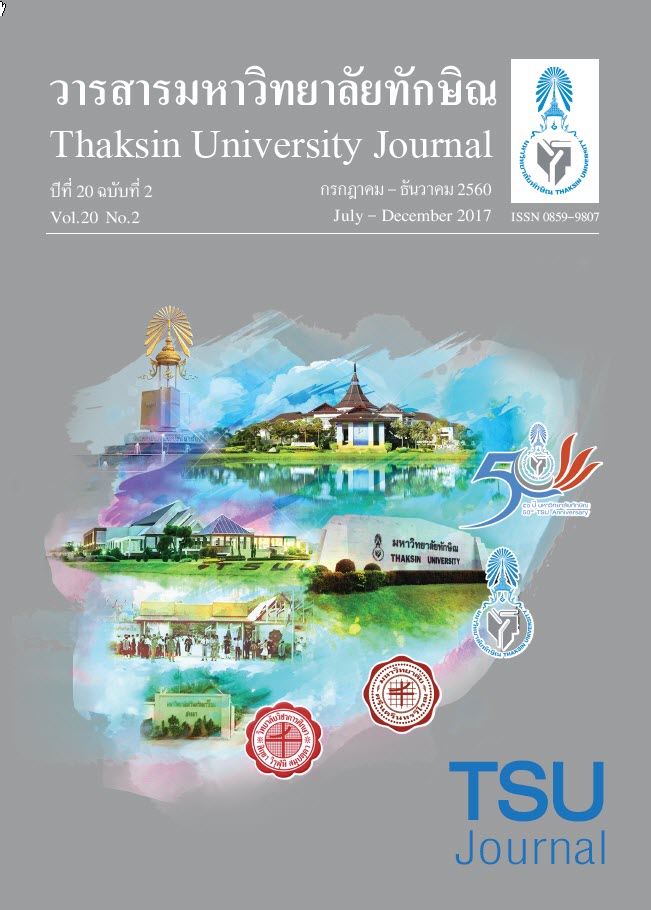The Nutrient Content of Various Compost from Organic Garbage in Nakhon Si Thammarat Rajabhat University
Main Article Content
Abstract
Nutrient contents from organic garbage in Nakhon Si Thammarat Rajabhat University were studied
and presented. It was found that the difference of nutrient contents on of the turned pile compost which were a pig and a goat manures, were statistically significant. The total amount of nitrogen in composting of the goat manure was found and equal to 0.00005%, the total amount of phosphorus in composting of the pig manure was found and equal to 0.000022% and the total amount of potassium in composting of the goat manure was also found in maximum value and equal to 0.000308%. Furthermore, the nutrient contents in the turned pile liquid compost were also studied and found not significant different. The total amount of nitrogen, phosphorus and potassium in turned pile liquid compost were found and equal to 0.2, 0.04 and 0.6 mg/l, respectively
Article Details
References
2015, from http://library.senate.go.th/document/Ext9853/9853519_0002.PDF.
[2] Dara, K and Theerapuncharoen, N. (2007). Maharaj Municipality’s Garbage Administration through
Participatory Action Research Amphur Maharaj Phranakhon Sri Ayutthaya Province. Master of Science.
Phranakhon Sri Ayutthaya: Phranakhon Sri Ayutthaya Rajabhat University.
[3] Pollution Control Department. (2015). Thailand State of Pollution Report 2015. Bangkok: Pollution
Control Department.
[4] Kajitvichyanukul, P. (1999). Water Supply and Sanitary Engineering 2542 (2). Bangkok: Ruenkaew Printing.
[5] Srithavirat, T. (2004). The Study on Composting Processes from Food and Agricultural Waste. Phitsanulok:
Pibulsongkram Rajabhat University.
[6] Agri-nature Foundation. (2010.). Feed the Soil and Let the Soil Feed the Plant. Bangkok: Eastern Printing.
[7] Suntararak, S. (2010). Quantitative analysis of macronutrients in the mixed of food scraps and agricultural
waste compost. Retrieved 15 December 2015, from http://kukr.lib.ku.ac.th/db/BKN/search_detail/
result/12238.
[8] Suwanakeree, S. (2004). Bio fFrtilizer or Bio Extract and Using Application on Effective Microorganism
(EM) Agricultural & Environmental. Center for Agricultural Resource Systems Research. Chiang Mai:
Chiang Mai University.
[9] Suriyanon, N. (2009). Effects of Passive Aeration on Household Organic Waste Composting. Master of
Engineering. Chiang Mai: Chiang Mai University.
[10] Saengsuwan, A. (2003). Liquid Organic Fertilizer Production from Organic Wastes. Master of Science.
Bangkok: Kasetsart University.
[11] Dengtongdee, S. and Panseng, S. (2006). Composting of Vegetable Waste. Phetchabun: Phetchabun
Rajabhat University.
[12] Polruksa, S. (2009). The Decomposting from Water Hyacinth Mixed with Manure Dropping and Bio-Catalyst.
Master of Public Health. Maha Sarakham : Maha Sarakham University.
[13] Pangnakorn, U. (2009). Application of wood vinegar to fermented liquid bio-fertilizer for organic agriculture
on soybean. Asian Journal of Food and Agro-Industry. Special Issue, 189-196.
[14] Hormchan, P. (2012). Determination of Nutrient Content (Nitrogen, Phosphorus and Potassium) from
Biological Fermentation. Surin: Rajamangala University of Technology Isan.
[15] Jaibuntha, S. (2007). Effects of Rice Bran on Organic Material Decomposition in Compost Production
Process. Master of Science. Chiang Mai: Chiang Mai University.
[16] Jiwnog, P. (2007). Relation between Nitrogen Sources and Compost Maturation Time. Master of Science.
Bangkok: Chulalongkorn University.
[17] Panpuang, N. and Chuntranuluck, S. (2012). A Comparative Study of Macronutrients in The Natural Compost,
Vermicompost by Eudrilus eugeniae and Compost Pd 1. Proceedings of 50th Kasetsart University
Annual Conference: Sciences, Natural Resources and Environment.Bangkok: Kasetsart University.


